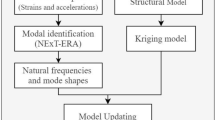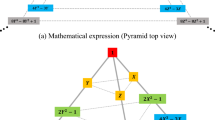Abstract
Expansion of measured dynamic response at a limited set of points is of great interest in the study of structural dynamic systems. Measurements at limited points on a structure can be expanded to unmeasured points by using System Equivalent Reduction Expansion Process (SEREP). However, a finite element model is required to obtain the mode shapes of the system. In this work, a non-model based expansion technique is proposed to expand the vibration characteristics at a sparse set of points to a much larger set of points without the use of a finite element model. Shape functions based on orthogonal polynomials can be used to decompose the deformation of vibrating structures into the summation of a set of shape functions with corresponding weighting coefficients. To obtain the vibration characteristics at an augmented set of points, measurements at a sparse set of points can be related to a set of shape functions which have the same mesh resolution as the sparse configuration. The vibration characteristics at an augmented set of points can then be reconstructed from the shape functions of the high resolution and scaled shape function weighting coefficients of the sparse configuration. Only a sparse set of measurements, geometry and coordinates of measured points are needed. In the work studied here, an analytical plate and a Base-Upright (BU) structure are used as samples to study the application of the proposed method. Both analysis and experiment are used to prove the concept.




















Similar content being viewed by others
References
Ma M, Sun C, Chen X (2018) Deep coupling autoencoder for fault diagnosis with multimodal sensory data. IEEE Trans Ind Inf 14:1137–1145
Zheng M, Peng P, Zhang B, Zhang N, Wang L, Chen Y (2015) A new physical parameter identification method for two-Axis on-road vehicles: simulation and experiment. Shock Vib 2015
Zhang S, Shen W, Li D, Zhang X, Chen B (2018) Nondestructive ultrasonic testing in rod structure with a novel numerical Laplace based wavelet finite element method. Latin American Journal of Solids and Structures 15
Kong L, Ostadhassan M, Li C, Tamimi N (2018) Pore characterization of 3d-printed gypsum rocks: a comprehensive approach. J Mater Sci 53:5063–5078
Qi H, Zhang B, Zhang N, Zheng M, Chen Y (2019) Enhanced Lateral and Roll Stability Study for a Two-Axle Bus Via Hydraulically Interconnected Suspension Tuning. SAE International Journal of Vehicle Dynamics, Stability, and NVH 3(1)
Sabato A, Niezrecki C (2017) Feasibility of digital image correlation for railroad tie inspection and ballast support assessment. Measurement 103:93–105
Sarrafi A, Mao Z, Niezrecki C, Poozesh P (2018) Vibration-based damage detection in wind turbine blades using phase-based motion estimation and motion magnification. J Sound Vib 421:300–318
Poozesh P, Sabato A, Sarrafi A, Niezrecki C and Avitabile P. A multiple stereo-vision approach using three-dimensional digital image correlation for utility-scale wind turbine blades
Qiao B, Zhang X, Gao J, Chen X (2016) Impact-force sparse reconstruction from highly incomplete and inaccurate measurements. J Sound Vib 376:72–94
O’Callahan J, Avitabile P and Riemer R (1989) System equivalent reduction expansion process (Serep). Proceedings of the 7th international modal analysis conference
Chipman C, Avitabile P (2012) Expansion of transient operating data. Mech Syst Signal Process 31:1–12
Pingle P and Avitabile P (2011) Prediction of full field dynamic Stress/strain from limited sets of measured data. Springer. Struct Dyn, 3
Carr J, Baqersad J, Niezrecki C, Avitabile P and Slattery M (2013) Predicting dynamic strain on wind turbine blade using digital image correlation techniques in conjunction with analytical expansion methodologies. Springer. Special Topics in Structural Dynamics, 6
Baqersad J, Poozesh P, Niezrecki C, Avitabile P (2017) Photogrammetry and optical methods in structural dynamics–a review. Mech Syst Signal Process 86:17–34
Chen Y, Joffre D, Avitabile P (2018) Underwater dynamic response at limited points expanded to full-field strain response. J Vib Acoust
Guyan RJ (1965) Reduction of stiffness and mass matrices. AIAA J 3:380–380
Paz M (1984) Dynamic condensation. AIAA J 22:724–727
Gordis JH (1992) An analysis of the improved reduced system (Irs) model reduction procedure. 10th International Modal Analysis Conference
Kammer DC (1991) A hybrid approach to test-analysis-model development for large space structures. J Vib Acoust 113:325–332
Chen Y, Zhang B and Chen S (2014) Model reduction technique tailored to the dynamic analysis of a beam structure under a moving load. Shock Vib 2014
Chen Y, Zhang B, Zhang N, Zheng M (2015) A condensation method for the dynamic analysis of vertical vehicle–track interaction considering vehicle flexibility. J Vib Acoust 137:041010
Avitabile P, Pingle P (2012) Prediction of full field dynamic strain from limited sets of measured data. Shock Vib 19:765–785
Chierichetti M, McColl C, Palmer D, Ruzzene M, Bauchau O (2011) Combined analytical and experimental approaches to rotor components Stress predictions. Proceedings of the Institution of Mechanical Engineers, Part K: Journal of Multi-body Dynamics 225:322–330
Chierichetti M, Ruzzene M (2012) Dynamic displacement field reconstruction through a limited set of measurements: application to plates. J Sound Vib 331:4713–4728
Schwarz BJ and Richardson MH (2014) Linear superposition and modal participation. Springer. Topics in Modal Analysis I 7:
Schwarz B., Richardson S. and Richardson M (2015) Using Mode Shapes for Real Time Ods Animation. Springer. Topics in Modal Analysis 10
Schwarz B, Richardson S and Richardson M (2015) Calculating Stress and Strain from Experimental Ods Data. Springer. Shock & Vibration, Aircraft/Aerospace, and Energy Harvesting 9
Yu M, Guo J and Lee K-M (2018) A modal expansion method for displacement and strain field reconstruction of a Thin-Wall component during machining. IEEE/ASME Transactions on Mechatronics
Wang W, Mottershead JE, Mares C (2009) Vibration mode shape recognition using image processing. J Sound Vib 326:909–938
Wang W, Mottershead JE, Mares C (2009) Mode-shape recognition and finite element model updating using the Zernike moment descriptor. Mech Syst Signal Process 23:2088–2112
Wang WZ, Mottershead JE, Patki A and Patterson EA (2010) Construction of shape features for the representation of full-field displacement/strain data. Appl Mech Mater
Wang W, Mottershead JE, Sebastian CM, Patterson EA (2011) Shape features and finite element model updating from full-field strain data. Int J Solids Struct 48:1644–1657
Wang W, Mottershead JE, Ihle A, Siebert T, Schubach HR (2011) Finite element model updating from full-field vibration measurement using digital image correlation. J Sound Vib 330:1599–1620
Wang W, Mottershead JE, Siebert T, Pipino A (2012) Frequency response functions of shape features from full-field vibration measurements using digital image correlation. Mech Syst Signal Process 28:333–347
Wang W, Mottershead JE (2013) Adaptive moment descriptors for full-field strain and displacement measurements. J Strain Anal Eng Des 48:16–35
Allemang RJ, Brown DL (1982) A correlation coefficient for modal vector analysis. In: Proceedings of the 1st international modal analysis conference
Khotanzad A, Hong YH (1990) Invariant image recognition by Zernike moments. IEEE Trans Pattern Anal Mach Intell 12:489–497
Mukundan R, Ong S, Lee PA (2001) Image analysis by Tchebichef moments. IEEE Trans Image Process 10:1357–1364
Liu F, Robinson BM, Reardon P, Geary JM (2011) Analyzing optics test data on rectangular apertures using 2-D Chebyshev polynomials. Opt Eng 50:043609
Qiao B, Chen X, Luo X, Xue X (2015) A novel method for force identification based on the discrete cosine transform. J Vib Acoust 137:051012
Algorri J, Urruchi V, Bennis N, Sánchez-Pena J, Otón J (2015) Tunable liquid crystal cylindrical micro-optical Array for aberration compensation. Opt Express 23:13899–13915
Salerno J. and Avitabile P (2014) Use of Zernike polynomials for modal vector correlation of small turbine blades. Springer. Special Topics in Structural Dynamics 6
Zeng G, Zhang B, Yao F, Chai S (2018) Modified bidirectional extreme learning machine with gram–Schmidt Orthogonalization method. Neurocomputing 316:405–414
Butland A, Avitabile P (2010) A reduced order, test verified component mode synthesis approach for system modeling applications. Mech Syst Signal Process 24:904–921
Nicgorski D, Avitabile P (2010) Conditioning of Frf measurements for use with frequency based substructuring. Mech Syst Signal Process 24:340–351
Thibault L, Avitabile P, Foley J, Wolfson J (2013) Equivalent reduced model technique development for nonlinear system dynamic response. Mech Syst Signal Process 36:422–455
Acknowledgements
Some of the work presented herein was partially funded by Air Force Research Laboratory Award FA8651-16-2-0006 “Nonstationary System State Identification Using Complex Polynomial Representations”. Any opinions, findings, and conclusions or recommendations expressed in this material are those of the authors and do not necessarily reflect the views of the particular funding agency. The authors are grateful for the support obtained. Distribution A. Approved for public release; distribution unlimited. (96TW-2018-0237).
Author information
Authors and Affiliations
Corresponding author
Additional information
Publisher’s Note
Springer Nature remains neutral with regard to jurisdictional claims in published maps and institutional affiliations.
Rights and permissions
About this article
Cite this article
Chen, Y., Logan, P., Avitabile, P. et al. Non-Model Based Expansion from Limited Points to an Augmented Set of Points Using Chebyshev Polynomials. Exp Tech 43, 521–543 (2019). https://doi.org/10.1007/s40799-018-00300-0
Received:
Accepted:
Published:
Issue Date:
DOI: https://doi.org/10.1007/s40799-018-00300-0





